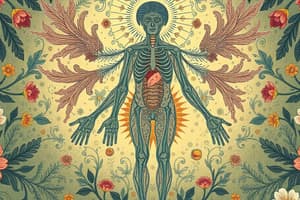Podcast
Questions and Answers
What is the correct order of structural organization in the human body?
What is the correct order of structural organization in the human body?
- Chemical, Cellular, Tissue, Organ (correct)
- Organ, Cellular, Chemical, Tissue
- Tissue, Cellular, Chemical, Organ
- Tissue, Organ, Chemical, Cellular
Which life process involves the ability to detect and respond to changes in the environment?
Which life process involves the ability to detect and respond to changes in the environment?
- Differentiation
- Reproduction
- Metabolism
- Responsiveness (correct)
What type of connective tissue is found in the intervertebral discs?
What type of connective tissue is found in the intervertebral discs?
- Elastic cartilage
- Fibrocartilage (correct)
- Dense regular connective tissue
- Hyaline cartilage
Which of the following correctly defines the term 'homeostasis'?
Which of the following correctly defines the term 'homeostasis'?
The function of red blood cells is to:
The function of red blood cells is to:
Which muscle is responsible for elevating the scapula?
Which muscle is responsible for elevating the scapula?
What is the main function of the lymphatic system?
What is the main function of the lymphatic system?
Which of the following is a disorder of the respiratory system characterized by airway inflammation?
Which of the following is a disorder of the respiratory system characterized by airway inflammation?
Which element plays a crucial role in muscle contraction?
Which element plays a crucial role in muscle contraction?
In which body cavity are the lungs located?
In which body cavity are the lungs located?
What is the function of the sinoatrial (SA) node in the heart?
What is the function of the sinoatrial (SA) node in the heart?
Which of the following best describes an isometric muscle contraction?
Which of the following best describes an isometric muscle contraction?
Which part of the nervous system is primarily responsible for the 'fight or flight' response?
Which part of the nervous system is primarily responsible for the 'fight or flight' response?
Which layer of the heart is responsible for contraction?
Which layer of the heart is responsible for contraction?
Which hormone stimulates uterine contractions during childbirth?
Which hormone stimulates uterine contractions during childbirth?
Which part of the digestive system is responsible for the absorption of most nutrients?
Which part of the digestive system is responsible for the absorption of most nutrients?
Flashcards are hidden until you start studying
Study Notes
Structural Organization of the Human Body
- Correct order: Chemical, Cellular, Tissue, Organ
- Levels of organization crucial for understanding biological function
Life Processes
- Responsiveness refers to detecting and responding to environmental changes
Connective Tissue
- Fibrocartilage is present in intervertebral discs, providing support and cushioning
Homeostasis
- Defined as the body's ability to maintain a stable internal environment
Red Blood Cells
- Main function: Transport oxygen and carbon dioxide in the bloodstream
Muscle Function
- Trapezius muscle is responsible for elevating the scapula, playing a key role in shoulder movement
Lymphatic System
- Principal function: Drains excess fluid and carries out immune responses, crucial for body fluid homeostasis
Respiratory Disorders
- Asthma is characterized by airway inflammation, affecting breathing
Cardiovascular System
- Left atrium receives oxygenated blood from pulmonary veins
Joint Types
- Pivot joints allow for rotation, exemplified by the atlas and axis (first two cervical vertebrae)
Epithelial Tissue
- Epithelial tissue lacks a significant extracellular matrix and covers body surfaces, forming glands
Endocrine System
- Hypothalamus regulates body temperature, hunger, and thirst, integrating signals from the body
Muscle Contraction
- Calcium plays a critical role in muscle contraction and function
Thoracic Cavity
- Lungs are located in the thoracic cavity, which houses respiratory organs
Sinoatrial Node
- SA node, the heart's natural pacemaker, is situated in the right atrium
Isometric Muscle Contraction
- Defined as a contraction where muscle length remains constant while generating force
Central Nervous System (CNS)
- Comprises the brain and spinal cord, coordinating all bodily activities
Skull Joints
- The skull bones are connected by fibrous joints, allowing limited movement
Integumentary System Functions
- Functions include protection, temperature regulation, and sensory reception; does not produce blood cells
Fight or Flight Response
- Controlled primarily by the sympathetic nervous system, preparing the body for rapid action
Rheumatoid Arthritis
- Characterized by joint inflammation, leading to pain and mobility issues
Blood as Connective Tissue
- Blood is classified as a liquid connective tissue, facilitating transport of nutrients and waste
Uterine Contraction Hormone
- Oxytocin stimulates uterine contractions during childbirth, important in labor
Heart Muscle Layer
- Myocardium is the layer responsible for the heart's contractions and pumping blood
Rotator Cuff Muscles
- Teres major is not part of the rotator cuff group, which includes supraspinatus, infraspinatus, and teres minor
Nutrient Absorption
- The small intestine is responsible for absorbing most nutrients from digested food
Pancreatic Hormones
- Insulin is a key hormone produced by the pancreas, regulating blood sugar levels
Studying That Suits You
Use AI to generate personalized quizzes and flashcards to suit your learning preferences.




